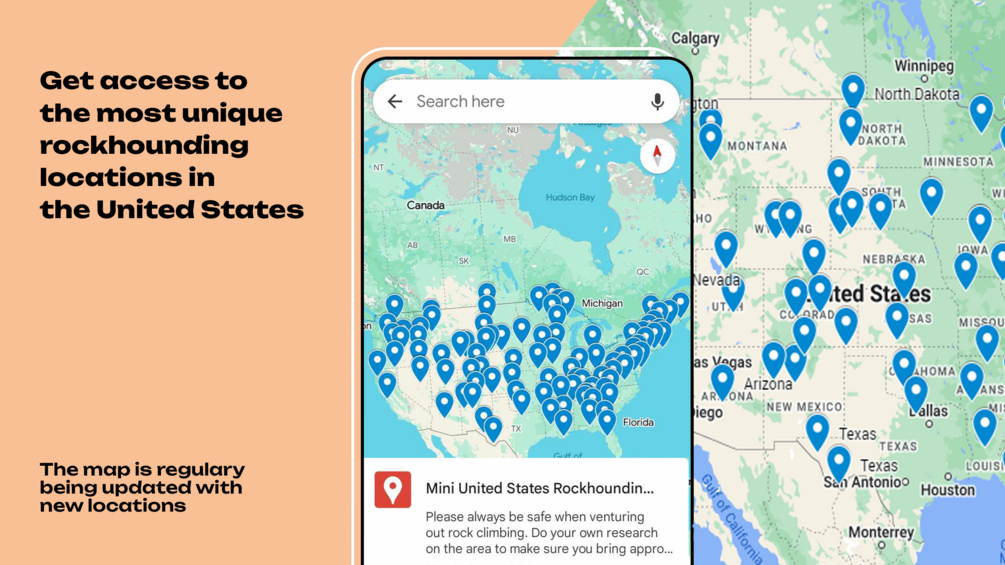Ready to unearth Ohio’s hidden gems?
You’re in for an adventure that’ll take you through the state’s rich geological playground. From the glimmering shores of Lake Erie to the ancient Appalachian foothills, Ohio offers a diverse terrain where rockhounding enthusiasts can find a treasure trove of minerals, fossils, and crystals.
Whether you’re a seasoned rockhound or just starting out, you’ll discover that Ohio’s landscape is peppered with prime spots ripe for exploration. You’ll find everything from colorful flint to the coveted Ohio geode.
So grab your gear and let’s delve into the best places to rockhound in the Buckeye State and the exciting finds that await you.
In Ohio, notable rockhounding locations include Flint Ridge for flint, Lake Erie shores for beach glass, Hocking Hills Region for quartz and garnets, Cincinnati Arch for fossils, and Caesar Creek State Park for Ordovician fossils. Always adhere to local regulations during your explorations.
Get our FREE United States Rockhounding Map HERE

Ohio Rockhounding Locations
Ohio’s vast geological diversity offers a multitude of locations for rockhounding. Whether you’re a beginner or an experienced collector, you’re sure to find spots teeming with geological treasures.
Flint Ridge is a must-visit for enthusiasts. Situated in east-central Ohio, the area is known for its high-quality flint, which Native Americans historically used for making tools and weapons. This unique flint can range in color from black to various shades of green, and even red.
Heading north, you’ll find the shores of Lake Erie, a prime spot for beachcombing. Here, you can search for colorful beach glass, as well as driftwood and small fossils eroded from coastal cliffs. Due to its accessibility, Lake Erie is perfect for a family outing with potential finds for everyone.
In the southern part of the state, the Hocking Hills Region invites you with a different variety of geological wonders. The area’s sandstone cliffs and waterfalls hide pockets where crystals like quartz and garnets are waiting to be discovered.
For fossil hunters, the Cincinnati Arch region is a goldmine. This area exposes ancient bedrock offering a plethora of fossils such as trilobites, brachiopods, and corals that once thrived in an ancient sea. Remember, while many specimens are loose and easy to collect, always refrain from damaging any protected rock formations.
Besides these, Ohio boasts numerous streams and riverbeds where rockhounds can sift through gravel and sediment. Caesar Creek State Park, for example, is known for its rich deposits of fossils where with permission, you can hunt for Ordovician fossils without the need for heavy tools.
| Location | Finds |
|---|---|
| Flint Ridge | Flint, Quartz |
| Lake Erie | Beach Glass, Driftwood, Fossils |
| Hocking Hills Region | Quartz, Garnets |
| Cincinnati Arch | Trilobites, Brachiopods, Corals |
| Caesar Creek State Park | Ordovician Fossils |
When planning your trip, it’s important to check if the areas require permits or have specific regulations. Always adhere to local laws and maintain respect for the natural environment to ensure these treasures remain available for future generations.
What Gemstones are Found in Ohio?

As you delve into your rockhounding journey in Ohio, you might wonder about the gemstones hidden beneath its soil. Ohio isn’t just a hub for fossils and flint; it’s also a treasure trove of gemstones that would sparkle in any collection.
First on the list is flint, a quartz variety renowned for its sharp edges and rich history as a primitive tool. Flint Ridge, as previously mentioned, is the place to be for sourcing the best samples of this mineral. But the state offers more than just flint. Enthusiasts can also stumble upon colorful agate. These banded beauties are most commonly discovered in the streams and gravel pits along the northeastern regions of Ohio.
Next, let’s talk about calcite, a crystal that can amaze with its variety of forms and colors. It’s found within the limestone and dolomite regions which are plentiful in Ohio, providing perfect conditions for crystal formation. Calcite is often unearthed during quarry digs, especially in the areas surrounding Clay Center.
Another gem Ohio boasts of is celestine. This mineral, known for its pale blue hue, catches the eye of collectors for its delicate beauty. It’s primarily found in the northwest, particularly in the areas of the Silica Shale.
While quartz crystals may seem commonplace, Ohio quartz possesses unique characteristics that set them apart. The clarity and quality of quartz specimens, especially in the form of ‘Herkimer diamonds’ from the northeastern part of the state, are a testament to Ohio’s geological diversity.
Keen collectors may also be on the hunt for pyrite, also known as fool’s gold. Its metallic luster and gold-like appearance make it a popular find. Although less prevalent, natural Ohio diamond or “quartz crystal” can sometimes be discovered, providing an exhilarating moment for rockhounds.
Remember, identifying prime rockhounding locations and what treasures they hide enhances your chances of a successful outing. Prepare to sift through riverbeds and quarry floors—you never know what Ohio gemstone might be waiting just under the next layer.
What Sedimentary Rocks You Can Find in Ohio?

When you’re rockhounding in Ohio, you’ll not only come across fascinating gemstones but also a variety of sedimentary rocks that tell a rich geological story. Ohio’s geological past has bestowed it with an abundance of sedimentary formations, which are primarily concentrated in the state’s western half.
Among the sedimentary treasures you can find are:
- Limestone
- Dolostone
- Shale
- Sandstone
Limestone, primarily composed of calcium carbonate, is prevalent throughout Ohio, especially around the Cincinnati Arch region. This area was once a warm, shallow sea, leaving behind extensive limestone deposits. You might also discover fossils within the limestone, which reveal the ancient marine ecosystems.
Dolostone, similar to limestone but with the added mineral dolomite, is another rock you may encounter. It’s easily identified by its somewhat crystalline texture and can be located in areas adjacent to limestone deposits.
Shale is commonly found in Ohio and is known for its fine-grained layers which can split easily. These rocks are often rich in organic material and can range in color from black to shades of gray depending on their carbon content.
Lastly, sandstone, formed from compacted sand, is encountered in Ohio. The most famous sandstone locale is the Hocking Hills Region where the rock has been eroded by natural forces, creating stunning landscapes and rock formations.
It’s important to remember that while you’re exploring these sedimentary rocks, respecting the land and its history is paramount. Ensure that you’re aware of the permissions and restrictions in place for collecting rocks in these areas.
| Rock Type | Composition | Notable Locations |
|---|---|---|
| Limestone | Calcium Carbonate | Cincinnati Arch Region |
| Dolostone | Calcium Magnesium Carbonate | Near Limestone Deposits |
| Shale | Fine-Grained Layers of Mud | Throughout Ohio |
| Sandstone | Compacted Sand | Hocking Hills Region |
These sedimentary formations are not only a window into Ohio’s geological past but also an exciting element of the state’s natural heritage that you can discover and study. Whether you’re an experienced rockhound or just starting, these rocks can offer a rewarding experience as you learn to identify and appreciate the subtle details that make them unique.
What Metamorphic Rocks are found in Ohio?
While Ohio is widely recognized for its fascinating array of sedimentary rocks, your rockhounding adventure isn’t complete without the hunt for metamorphic rocks. These rocks have undergone transformation through heat, pressure, or chemically active fluids.
Serpentinite is one of the metamorphic rocks you might come across in Ohio, particularly in the state’s eastern regions. This rock’s wavy, snake-like patterns are not only mesmerizing but also a clue to its past as a part of the earth’s deep oceanic crust.
Here are some locations where you’re likely to find metamorphic rocks in Ohio:
- The Eastern Ohio Serpentinite Belt
- The Serpent Mound Disturbance area
Slate, another metamorphic rock, can sometimes be spotted in Northeast Ohio. Slate forms from shale through low-grade metamorphism and often features a fine-grained, foliated texture. It’s commonly known for its use in historical building materials, but for rockhounds, finding a piece of natural slate can be quite thrilling.
Expect to find metamorphic rocks such as slate at:
- Parts of the Pottsville Escarpment
- Bucyrus, Ohio area
In addition to serpentinite and slate, Quartzite may also be unearthed during your Ohio rockhounding escapades. Originally pure quartz sandstone, quartzite undergoes heating and compression to form a hard, non-foliated rock that’s tougher than the original sandstone.
Ohio’s quartzite is mainly found in:
- The Bedford Shale area
- Near Bellefontaine
What Igneous Rocks can You Find in Ohio?
As you delve deeper into Ohio’s rich geological tapestry, you’ll find that igneous rocks are not as common as sedimentary and metamorphic types. However, they’re not entirely absent. Indeed, Ohio’s igneous rocks primarily consist of rare finds like basalt and diabase, often hidden beneath the more prevalent sedimentary layers.
When exploring areas where volcanic activity occurred millions of years ago, you have a chance to stumble upon these igneous formations. These rocks chiefly originate from ancient volcanic flows and offer a glimpse into Ohio’s fiery past. Sites where you might encounter igneous rocks include ancient buried lava flows and deep wells where diabase has been uncovered.
In the search for igneous rocks, you’re likely to notice that they are typically harder and denser than the sedimentary rocks you’ve seen. Their crystals formed from the cooling and solidifying of molten magma, which sometimes rushed to the surface or cooled slowly deep within the Earth’s crust. These processes result in a textured array of igneous rocks that boast a variety of colors and grain sizes.
Here’s a quick rundown of igneous rocks in Ohio:
- Basalt: A fine-grained rock that’s usually gray to black.
- Diabase: Similar to basalt but with larger, visible crystals.
For the best chance at finding these unique rocks, focus your efforts on the western part of the state, where geological research indicates past volcanic activity. Remember, while igneous rocks are scarce, discovering them can be a rewarding experience for both novice and seasoned rockhounds alike.
Keep an eye out for these igneous treasures whilst you traverse the Ohio landscapes; although they might require a keener eye and perhaps a touch more luck, their discovery adds to the excitement and variety that rockhounding in Ohio offers. As you venture out, always be mindful of property rights and ensure that you’re collecting in accordance with local regulations and with respect for the environment.
Panning for Gold in Ohio
While Ohio might not be the first state that comes to mind for gold panning, it’s a pastime that has intrigued many enthusiasts in the Buckeye State. Bearing a rich glacial history, Ohio’s streams and rivers can yield surprising treasures for those willing to sift through their waters. Gold flakes and small nuggets have been found, particularly in the southwestern part of the state. It’s this allure of the potential for discovery that keeps gold panning aficionados returning to Ohio’s waters.
If you’re new to gold panning in Ohio, you’ll want to focus on areas where glaciers once passed through, as they’re known for dragging gold-bearing soil from other regions. Bellville, Butler, and Clear Fork Rivers are hotspots that you should definitely check out. The Swank West is a popular site located at Richland County where members can pan. Butler’s Kokosing River and the elusive creeks of Clermont County, known for fine flour gold, also hold potential for your panning expeditions.
Remember to stay informed about local regulations before you start swirling your pan. While public lands allow gold prospecting, it may be restricted or require permits. Private lands will need the landowner’s permission, so always ensure you’re panning legally. You’ll need to arm yourself with a sturdy pan, some tweezers for picking out gold flakes, and maybe a sluice box if you’re looking to upgrade your experience.
Gold panning in Ohio is often more about the excitement of the activity and less about striking it rich. You’re immersing yourself in nature, potentially walking away with small pieces of natural wealth. Don’t expect huge payoffs, but do enjoy the tranquility and potential to uncover a sparkly treasure from Ohio’s waters. Keep a keen eye, a steady hand, and a patient mind as you swirl the waters in hopes of catching that glimmer of gold.
Rocks and Minerals Found in Ohio
Ohio’s geological landscape is a treasure trove for rockhounds. As you explore the state’s diverse terrains, you’ll come across an impressive array of rocks and minerals that have fascinated collectors and geologists alike.
Flint is the official gemstone of Ohio and can be predominantly found at Flint Ridge. This variety of quartz sparkles with colors ranging from white and pink to green and red. Lake Erie’s shores are ideal for collectors in search of colorful beach glass and interesting driftwood, which, while not minerals, are coveted by many hobbyists.
In the sediment-rich areas of the Cincinnati Arch region, you’ll discover specimens of trilobite fossils, evidence of Ohio’s ancient marine past. The Hocking Hills Region is home to dazzling quartz crystals, often hidden within its scenic caverns and valleys.
Moreover, Ohio’s rivers and streams are perfect for unearthing geodes, spherical rocks that contain a hollow cavity lined with crystals. These natural wonders are particularly prevalent in the state’s southwestern regions.
The Caesar Creek State Park is a hotspot for finding brachiopods, gastropods, and even horn corals. Be sure to follow the park’s guidelines which typically allow for the collection of fossils as long as you use no tools and take only what you can hold in your hand.
For those interested in more precious finds, Ohio does provide a unique opportunity. Small diamonds have occasionally been discovered within the state. These finds are rare and often require a lot of patience, but they showcase the surprising diversity of Ohio’s geological offerings.
| Gemstone or Mineral | Common Locations in Ohio |
|---|---|
| Flint | Flint Ridge |
| Beach Glass | Lake Erie’s Shores |
| Driftwood | Lake Erie’s Shores |
| Trilobite Fossils | Cincinnati Arch Region |
| Quartz Crystals | Hocking Hills Region |
| Geodes | Southwestern Ohio |
| Brachiopods | Caesar Creek State Park |
| Gastropods | Caesar Creek State Park |
| Horn Corals | Caesar Creek State Park |
| Small Diamonds | Sporadic Locations Statewide |
Where Can I Find Fossils in Ohio?
Ohio boasts a rich tapestry of prehistoric life, and you can find fossils scattered throughout the state. If you’re an enthusiast, Ohio’s fossil locales are not to be missed. The Cincinnati Arch region is a hotbed for Ordovician fossils, making it a prime spot for collectors. Here’s where your adventure begins:
- Trammel Fossil Park: Located near Sharonville, this park offers a vast area where you can freely hunt for fossils. Common finds include brachiopods, bryozoans, and trilobite remnants.
- Caesar Creek State Park: As mentioned earlier, this park requires a permit for fossil hunting, which you can obtain at the U.S. Army Corps of Engineers Visitor Center. Once you have it, you’re on your way to discovering a variety of fossils including trilobites and brachiopods. Remember, Ohio law mandates that you must not remove large specimens.
When exploring the Hocking Hills Region, keep your eyes peeled for the remnants of ancient marine organisms embedded in the rock layers. While less known for fossils than the previous regions, Hocking Hills can surprise you with its hidden treasures.
For an urban twist on fossil hunting, head to Cleveland’s Big Creek Park, where remnants of prehistoric Ohio are waiting beneath your feet in the middle of the city. This location is especially recommended if you’re new to rockhounding, giving you a taste of urban palaeontology.
Remember, when hunting for fossils in any of these areas, you’re not just looking for rocks; you’re uncovering pieces of Earth’s ancient history. It’s essential to respect the sites:
- Do not use heavy tools or explosives
- Leave the site as you found it
- Refrain from trespassing on private property without permission
Be sure to research the specific regulations of each fossil hunting location. Not all sites have the same rules, and respecting these will ensure these treasures continue to be available for generations of rockhounds to come.
Ohio Rockhounding Laws & Regulations
When you’re planning your rockhounding adventure in Ohio, it’s crucial to be aware of the state’s rockhounding laws and regulations to ensure a legal and ethical outing. Ohio Department of Natural Resources (ODNR) manages and enforces the rules that you must follow while rockhounding.
In many areas, including state parks and nature preserves, rockhounding is permissible, but you’re often required to obtain a permit. For instance, at Caesar Creek State Park, permits for fossil collection are mandatory and can be obtained at no cost from the Visitor Center.
Here are some general guidelines to keep in mind:
- Collecting for commercial purposes is usually prohibited.
- Use of tools may be restricted to hand tools, with mechanized equipment generally not allowed.
- There is often a cap on how much material you can remove, typically for personal use only.
- Digging in designated wilderness areas, historical sites, or archaeological sites is forbidden.
- It’s your responsibility to know the boundaries of the collecting area to avoid trespassing on private property.
Specific Laws:
- The Archaeological Resources Protection Act (ARPA): It’s illegal to disturb any archaeological sites or remove artifacts.
- The Lacey Act: This law combats trafficking in “illegal” wildlife, fish, and plants, which extends to illicitly obtained rocks and fossils.
Before you set out, check recent updates from local authorities or the ODNR website. Collecting spots like Trammel Fossil Park are an exception where fossils can freely be collected without a permit, but regulations still apply to the amount and manner in which you collect.
Remember:
- Always leave the site as you found it,
- Respect wildlife and natural features,
- Carry out any trash you bring in,
- Fill any holes you dig,
- And observe all posted signs and guidelines.
Rockhounding can be a rewarding hobby that deepens your appreciation for Ohio’s geologic history. By adhering to these laws and regulations, you’re ensuring that these natural treasures will continue to be accessible and the environments undamaged for fellow enthusiasts and future explorers.
Rockhounding Tips for Beginners in Ohio
Gearing Up: Essential Tools for Rockhounding
When you’re just starting on your rockhounding adventure, having the right tools can make all the difference. Essential gear includes a sturdy hammer for breaking rock, a chisel to pry specimens from their rocky homes, and a good quality pair of gloves to protect your hands. Consider a backpack to carry your finds and a field guide to help identify them. You’ll also need a set of small brushes to clean off debris and soft packaging material like newspaper or bubble wrap to transport your treasures safely. Moreover, don’t overlook the importance of a portable first-aid kit for those just-in-case scenarios.
- Sturdy hammer
- Chisel
- Durable gloves
- Backpack
- Field guide
- Small brushes
- Soft packaging materials
- Portable first-aid kit
Safety Tips While Rockhounding
Safety should be your top priority as you explore Ohio’s diverse geological landscapes. Always wear protective gear such as safety glasses or goggles to shield your eyes from flying debris. Sturdy boots with good traction can prevent slips and falls on uneven terrain. Let someone know your itinerary and expected return time. Stay hydrated, especially during the hot summer months, and be aware of the weather conditions to avoid being caught in a dangerous situation. Also, remember that cliff faces and quarry walls can be unstable, so keep a safe distance to avoid rock slides.
- Wear protective gear
- Sturdy boots
- Share your itinerary
- Keep hydrated
- Monitor weather conditions
- Maintain distance from potential hazards
Legal Guidelines for Rockhounding Enthusiasts
Abiding by legal guidelines ensures that you can enjoy rockhounding without harming the environment or landing in legal trouble. Firstly, obtain permission to collect on private land, and adhere to the regulations set by public parks and nature reserves. It’s essential to know that the removal of artifacts from any state or national parks is illegal. Familiarize yourself with Ohio’s laws on fossil and rock collection, including the need for permits in certain locations. Avoid disrupting wildlife habitats, and practice the leave-no-trace principles to minimize your environmental impact.
- Obtain permission for private lands
- Adhere to public land regulations
- Avoid removing artifacts from state or national parks
- Familiarize with Ohio collection laws
- Permit requirements
- Practice leave-no-trace principles
Conclusion: Ohio Rockhounding Map
Armed with the right tools and knowledge of safety and legal guidelines you’re set to explore Ohio’s rich geological offerings.
Remember to respect the land and its laws as you search for hidden geological treasures. With every piece you discover you’re not just finding a rock or mineral—you’re uncovering a piece of Earth’s history. So grab your gear and set out on your adventure with confidence.
Ohio’s natural wonders await.



![Nebraska Rockhounding Sites in [year]: Locations & Treasures](https://observationhobbies.com/wp-content/uploads/2024/01/lMVu7TzpaadhkVIDr6l3R-768x439.jpg)



